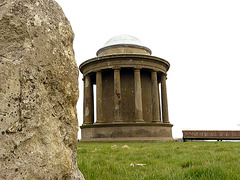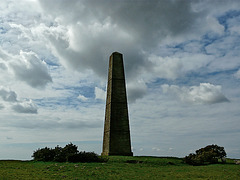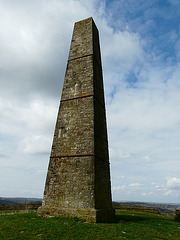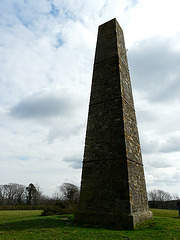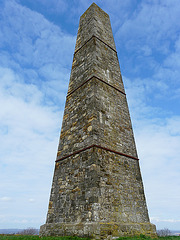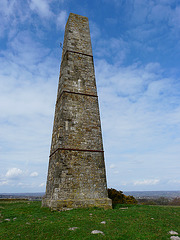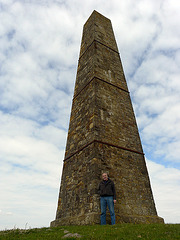C.Rayz's photos
18. Temple Stones
| |
|
Carved stones behind the Temple Folly.
For more information about them you can visit his site:
John Fuller Follies
19. Temple Stones
| |
|
On 20 September, 1808 Covent Garden Theatre burnt down. It was redesigned by Sir Robert Smirke opening less than a year later on 18 September, 1809. It demonstrates the neo-classical style so much in favour at the time and probably the inspiration for this Temple.
For more information about them you can visit his site:
John Fuller Follies
20. Temple Sussex Heritage Trust
| |
|
The upkeep for this wonderful treasure is maintained by the Sussex Heritage Trust.
For more information about them you can visit his site:
John Fuller Follies
21. Temple Leaving
| |
|
The Rotunda Temple has spawned several stories about Fuller and his cohorts.
Unfortunately, we may never know exactly what went on.
For more information about them you can visit his site:
John Fuller Follies
1. Obelisk Dominates Landscape
| |
|
Also known as the Brightling Needle, this obelisk stands atop a hill, variously known as Brightling Down and Brightling Beacon, that is 646 feet (187 m) above sea level, making it the second highest point in East Sussex.
For more information about them you can visit his site:
John Fuller Follies
2. Obelisk Side 1
| |
|
The reason for its existence is open to conjecture.
For more information about them you can visit his site:
John Fuller Follies
3. Obelisk Side 2
| |
|
Some sources claim that it was erected to commemorate Nelson's victory at Trafalgar in 1805.
For more information about them you can visit his site:
John Fuller Follies
4. Obelisk Side 3
| |
|
Still others purport that it stands in celebration of Wellington's victory over Napoleon in 1815.
For more information about them you can visit his site:
John Fuller Follies
5. Obelisk Side 4
| |
|
In 1985, extensive renovations were carried out to strengthen and stabilize the obelisk.
For more information about them you can visit his site:
John Fuller Follies
6. Obelisk Cut Bench Mark
| |
|
Ordenance Surverors marks.
For more information about them you can visit his site:
John Fuller Follies
7. Obelisk Looking Up
| |
|
Two local men who were involved with earlier repairs scratched these words into the structure: R Croft, 1899; and Charles Croft, July 29, 1889, aged 16 years.
For more information about them you can visit his site:
John Fuller Follies
8. Obelisk Growth
| |
|
It seems odd that there is no inscription on the monument, another mystery left by Jack Fuller.
For more information about them you can visit his site:
John Fuller Follies
9. Obelisk For Scale
| |
|
The obelisk itself is 65 feet (20 m) high.
My friend is 6" 4' tall :)
For more information about them you can visit his site:
John Fuller Follies
1. Observatory Front
| |
|
Designed by Sir Robert Smirke for Jack Fuller in 1810, the Brightling Observatory was completed in 1818.
For more information about them you can visit his site:
John Fuller Follies
2. Observatory Dome Door
| |
|
The Observatory was equipped with expensive equipment including a Camera Obscura. During the 19th century, room Camera Obscuras became very popular across Europe.
For more information about them you can visit his site:
John Fuller Follies
3. Observatory Back
| |
|
It is commonly believed that Fuller's inspiration for building the Observatory came from his friend and noted astronomer Sir William Herschel. Born Friedrich Wilhelm Herschel in Germany, Herschel is perhaps best known for his discovery of the planet Uranus in 1781.
For more information about them you can visit his site:
John Fuller Follies
4. Observatory Dome Structure
| |
|
In the autumn of 1964 John Vetterlein was engaged by Commander Hugh Malleson (Royal Navy retired), then owner of the observatory, to assess its viability. The following is an abstract from a mongraph written by Vetterlein and published by Spring Ast LIX, Springfield, Rousay, Orkney, 2001.
" ...The observatory was close to the highest piece of ground (620 feet OD marked by an obelisk) for many miles and was ideally suited (or was in the days of its inception, Eastbourne now posing a light pollution hazard) for astronomical work.
I found the dome (approximately 8 feet in diameter) had been surmounted by a Negretti and Zambra cup anemometer, the control panel being read in the main room of the house on the ground floor. The narrow shutters were hinged but immovable, as was the dome itself, the large iron wheels on which it stood having seized.
We undertook to remove the shutters and to replace them with a single lateral sliding stainless steel shutter. In addition we agreed to free the wheels and to conduct experiments to see if it might be possible to attach a motor drive for rotating the dome. "
For more information about them you can visit his site:
John Fuller Follies
5. Observatory
| |
|
Artists used different types of Camera Obscura to trace accurate images from nature and incorporate these images into their drawings and paintings. With this in mind, one wonders if frequent visitor to Rose Hill, J M W Turner may have made use of the Camera Obscura while there.
For more information about them you can visit his site:
John Fuller Follies


